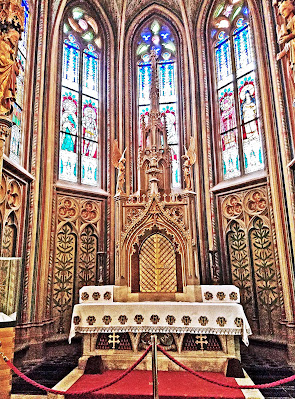After returning to the InterContinental Hotel after the morning shore excursion, we then boarded a motorcoach for the rescheduled included shore excursion, Panoramic Budapest, which started with a quick run-through of Pest.
 |
| Apáczai János Csere emlékmű/ János Csere Apáczai Memorial (1961, by Tibor Vilt) for the Transylvanian Hungarian educator who wrote the first textbook in Hungarian |
 |
| Nagyboldogasszony Főplébánia-templom/ Assumption Inner City Parish Church (1725-1739, by György Pauer János in Baroque style) |
At the top right on the hill is Hegedűs Villa (1913-14, by Ferenc Császár, after a villa in Genoa, Italy), a former waterworks building, now housing a company that provides steam heat to the neighborhood. How many people in the United States have heard of heated sidewalks throughout a city, or a single power plant that can provide heat and air conditioning to all area businesses?
 |
| Gosh, the elegant Magyar Állami Operaház/Hungarian State Opera House (1875-1884, by Miklós Ybl in Neo-Renaissance style) is covered in scaffolding |
 |
| Food delivery service folks wait outside Burger King |
Following World War II, the "House of Terror" became the headquarters of the Állambiztonsági Hatóság/ÁVH/State Security Authority (1948-1956), which was essentially the secret police of the Hungarian Communist Party under Soviet influence. This was the era of forced confessions and executions without trials, and people wary that a neighbor could turn them in for little reason.
However, the House of Terror Museum, which was created in 2002 by the current Hungarian government, has been controversial. They seem to want the world to equate Facism with Communism, and to excuse Hungarians as the victims of these regimes, as we have heard before.
 |
| To the far left is a piece of the Berlini fal/Berlin Wall |
 |
| Első világháborús vasútas hőseinek emlékmű/ World War I Memorial to Railway Workers (KSS) |
 |
| Entry to the Budapest Metro (KSS) |
 |
| Hősök tere/Heroes' Square (1986-1906, for the Millennium of the founding of Hungary in 896) is filled with stage scaffolding and seating for outdoor concerts |
 |
| On the right side of Heroes' Square is the Műcsarnok/ Kunsthalle/Museum of Contemporary Art (1896, by Albert Schickedanz and Fülöp Herczog with a portico in Greek Revival style) (KSS) |
 |
| On the left side of the square is the Szépművészeti Múzeum/ Museum of Fine Arts (1900-1906, by Albert Schickedanz and Fülöp Herczog in eclectic Neoclassical style) (KSS) |
 |
| Erzsébet Boulevard at Wesselényi Street with a tram, cars, and pedestrians and probably few problems |
 |
| Kossuth Lajos Street #11 with banner |
 |
| The banner may be a bit optimistic! |
 |
| Okay, now we are on the Buda side! At the entrance to the Várkert Bazár/Castle Garden Bazaar (1875-1883, by Miklos Ybl in Neo-Renaissance style) is an ornamental garden used for concerts and exhibitions |
 |
| View from below of Halászbástya/Fisherman's Bastion (1899-1905, by Frigyes Schulek, on 1700s foundation walls, damaged in WWII, restored in 1953) |
We left the motorcoach to walk up on Castle Hill.
 |
| Houdini-ház/Houdini House is a museum devoted to Harry Houdini, who was born in Budapest as Erik Weisz; his family moved to the United States when he was four years old |
 |
| Honvéd-szobor/Statue of the Independence War (1893, by Zala György) is dedicated to the defenders of the Buda Castle in 1849 (KSS) |
 |
| Tárnok Street #14 is a medieval trading house that has been restored by painting in a 16C pattern |
 |
| Mátyás Templom/Matthias Church (est 1015, rebuilt multiple times including as a mosque by the Ottomans in 1541, 1874-1896 rebuilt by Frigyes Schulek in late Gothic style, damaged during WWII, repaired) |
 |
| Matthias Church interior; the church carries the name of Matthias because he began his reign here in 1458 and was married here twice |
 |
| The Chapel of Loreto contains a statue of Mary and Child (1515) which was in a niche plastered over by locals when the Ottomans converted the church into a mosque |
 |
| Up a spiral staircase to the gallery with a museum of ecclesiastical objects including copies of the Hungarian coronation treasures (for a closer look) |
 |
| The statue of Mary wears a life-size copy of the Holy Crown blessed by Pope John Paul II in 2000 (KSS) |
 |
| View of the nave with flags brought from the countries represented at the coronation of the Hapsburg Hungarian King Franz Joseph in 1867 |
Next: More Buda.











No comments:
Post a Comment